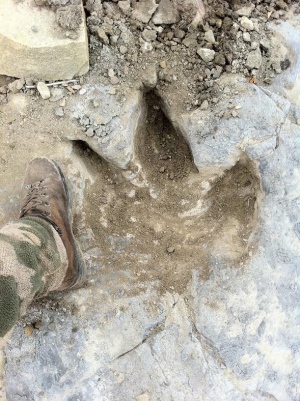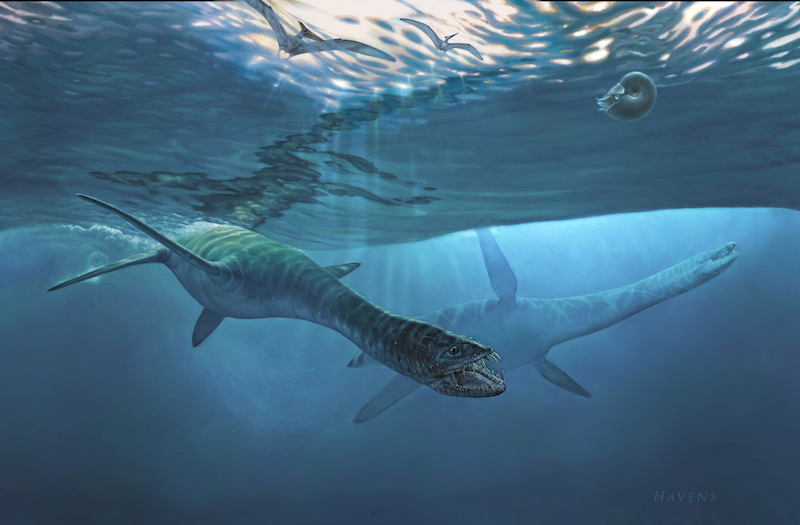Maybe you don’t think of hunters as amateur paleontologists, but they often can be. A few years ago, Aaron Fredlund was guiding a group of moose hunters in British Columbia when he walked by a three-toed foot print of a tyrannosaur. Further south in Montana, elk-hunter David Bradt, discovered a 70-million-year-old elasmosaurids fossil while hunting in 2010.

A tyrannosaur footprint discovered by hunting guide Aaron Fredlund. Photo: Aaron Fredlund
And, today, Bradt’s prehistoric, sea-creature is making news once again. Thanks to a recent article published on Wednesday, April 12, in the Journal of Vertebrate Paleontology, experts have confirmed the preserved skeletal remains belonged to a previously unknown genus and species within Elasmosauridea.
What’s It Like to Find a 70-Million-Year-Old Fossil?
The fossil was discovered 50 miles south of Malta, Montana, by Bradt, a rancher from Florence. He was elk hunting a remote area at Bearpaw Shale. As reported by the Billings Gazette nearly six years ago, the shale formation was once a muddy bottom of the Bearpaw Sea, an ancient 1,000-mile-wide sea that stretched from the Artic to the Gulf of Mexico. Dinosaur remains have also been discovered at Bearpaw Shale, including the complete skull and postcranium of a Kritosaurus.
Bradt has two boys: one was 8 years-old and the other was 10 when the excavation began. “Both of them loved it,” Bradt said in an interview with the Billings Gazette. “It was pretty neat. We did just about everything. The main jobs were diverting the creek and digging through the mud looking for parts.”
And there was one unusual thing about this particular fossil: it’s rare to find the skull with the rest of the skeleton. Yet, in the case of this elasmosaurid, the sea creature died with its tail wrapped around its body. So, in effect, it kept its body intact and did a solid for the diggers by making the excavation efficient. This also minimized the work’s impact on the creek.
The Elasmosaurids Had Freakishly Long Necks
At first, excavators thought the fossil was a plesiosaur, a species within the same family as the elasmorsaurs. Then, they determined it was an elasmosaurids. These creatures had small skulls and necks with 70 or more neck vertebrae. So, while the fossil discovery was unique because so much of the creature was intact, this still wasn't certain to be a finding of something previously unknown. After all, elasmosaurids are old news in the world of paleontology. They’ve been studied since the early 19th century. (Duh.)
What’s a paleontology story without a Ross meme?
But, according to this month's recent study abstract from the Journal of Vertebrate Paleontology, the fossil Bradt found does introduce a new genus and, even before, past findings have been contentious due to various factors including limited taxon sampling:
This is particularly true for elasmosaurids, a Cretaceous clade of long-necked plesiosaurians. In 2010, a new, nearly complete skeleton, MOR 3072, was collected from the Late Cretaceous (Campanian–Maastrichtian) Bearpaw Shale of northeast Montana. The specimen provides detailed morphological information rarely observed within Elasmosauridae, including a complete skull, the anterior 23 cervical vertebrae, a partial dorsal and caudal vertebral column, incomplete pectoral and pelvic girdles, elements of both fore- and hind limbs, ribs, and gastralia.

Illustrated rendering of an elasmosaurids.
Being early Maastrichtian in age, MOR 3072 is the stratigraphically youngest elasmosaurid known from the Western Interior Seaway and is recognized as a new genus and species, Nakonanectes bradti.
The earliest elasmosaurids were small, nearly 10 feet long; while they could grow as large as 46 feet long the end of the Cretaceous period. (Reminder: Bearpaw Shale in Montana is a geologic formation of the Late Cretaceous age.) Their necks, though, were the longest among all plesiosaurs, ranging anywhere from 32 to 76 cervical vertebrae. They weighed up to several tons.
Even seven years ago, when two paleontologists were on site at Montana’s Bear Shale, something wasn’t adding up. An elasmosaur could reach lengths up to 40 feet. But the elk hunter’s discovery in Montana was only an 18-foot sea creature. The two paleontologists on site at the time, the Billings Gazette reported, suspected a different species from what had been previously discovered.
And now, several years later, this suspicion has been confirmed, making the elk hunter’s hunt even weightier than originally perceived. It also makes Bradt an amateur paleontologist.
Related: Amazing Fossils Found By Ordinary People
Featured photo courtesy of the U.S. Fish and Wildlife Services






